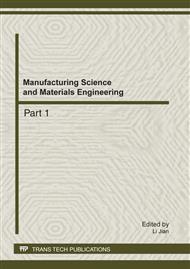p.138
p.144
p.150
p.156
p.160
p.166
p.169
p.177
p.183
The Study of Residual Stresses in High-Speed Milling of Titanium Alloy TC11
Abstract:
In order to provide experimental evidence for optimizing high-speed milling parameters and controlling surface integrity, the effects of cooling conditions, tool rake angle and milling parameters on machined surface residual stresses were investigated in high-speed milling titanium alloy TC11. The residual stresses were measured by XStress3000 X-ray stress analyzer, and three points were tested on each workpiece surface, then take average. The milling parameters were optimized based on fatigue performance. The results show that the emulsion cooling get the highest surface residual compressive stress and the dry cutting get the lowest residual compressive stress. With the increasing of cutting tool rake angle, surface residual compressive stresses increase. The most effect on the residual stresses of surface is milling width, next are feed per tooth and milling depth, and the last is milling speed. In the experimental range, the optimized high-speed milling parameters are: vc=377m/min, fz=0.03mm/z, ap=0.2mm, ae=7.5mm.
Info:
Periodical:
Pages:
160-165
Citation:
Online since:
January 2012
Authors:
Price:
Сopyright:
© 2012 Trans Tech Publications Ltd. All Rights Reserved
Share:
Citation:


